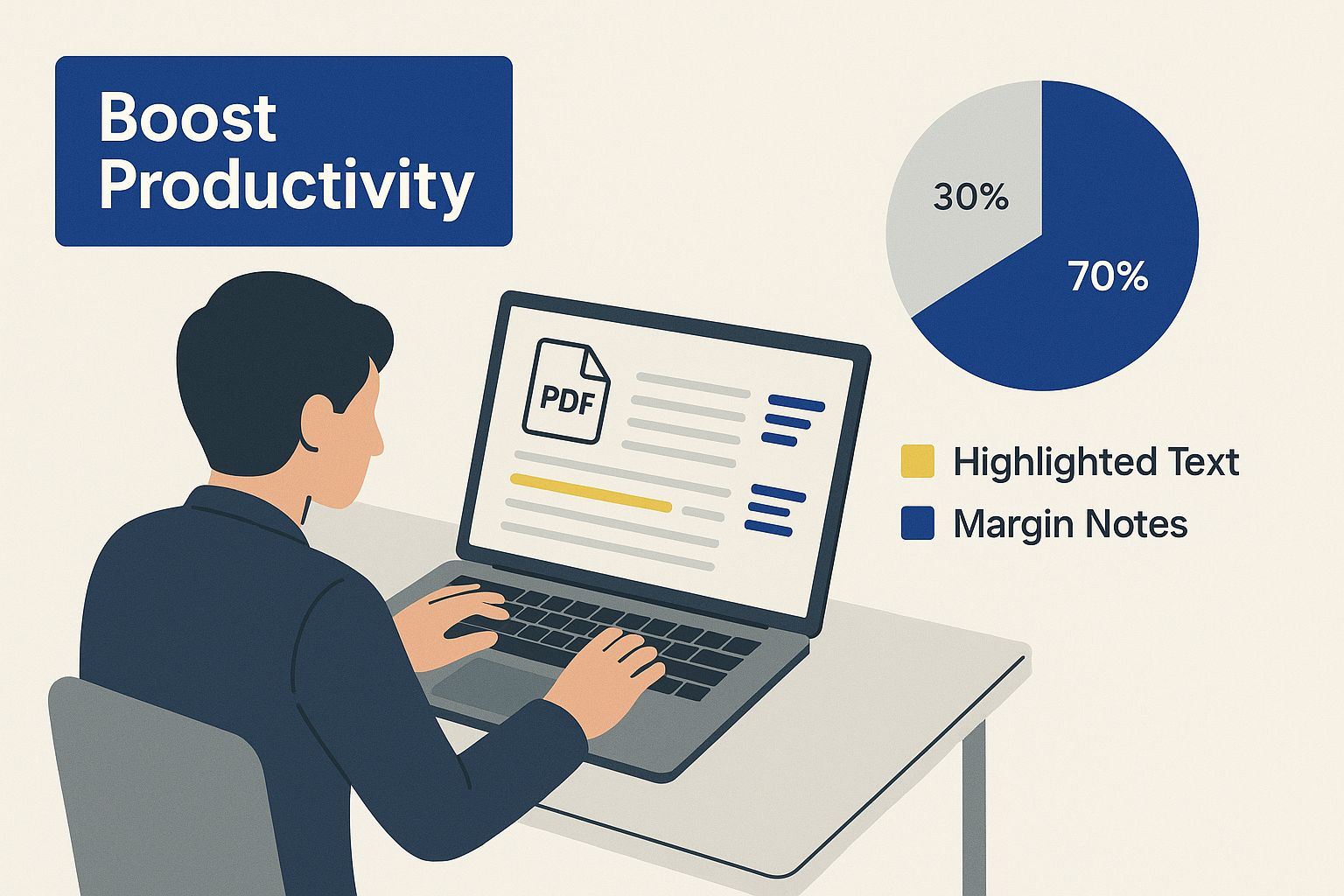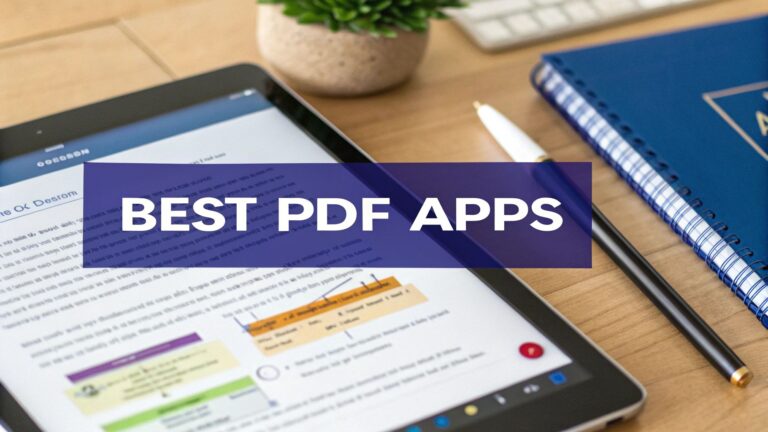Why Online PDF Annotation Is Changing How We Work
The way we interact with documents has evolved. We're no longer tied to printed paper and highlighters. Online PDF annotation is transforming how we work, providing a dynamic and efficient alternative to traditional markups. This means collaboration, review processes, and overall productivity are being reshaped by this essential technology.
Streamlining Workflows Across Industries
In education, teachers can provide more effective feedback on student work using online PDF annotation. They can go beyond simple corrections to offer in-depth commentary and targeted suggestions. Legal teams can also streamline document review by collaboratively annotating contracts and legal briefs, eliminating the need for lengthy email chains or in-person meetings. This shift towards digital collaboration is becoming essential, particularly in remote and hybrid work environments.
Healthcare providers are also enhancing patient documentation through online PDF annotation. This allows for quick access and sharing of vital information, ultimately improving patient care. The ease of sharing, accessing, and collaborating on documents in real-time makes online PDF annotation an invaluable tool across various sectors.
The Psychological Shift to Digital Markup
The move from physical to digital markup is more than just a change in tools; it represents a significant shift in mindset. Professionals who embrace online PDF annotation report substantial improvements in both the quality of their collaboration and processing speeds. This increased efficiency stems from the ease with which digital annotations can be organized, searched, and shared, contributing to a greater sense of control over the collaborative process.
This growing reliance on online PDF annotation is reflected in current market trends. The global market for data annotation tools, which encompasses online PDF annotation technologies, is expanding rapidly. In 2023, this market was valued at approximately USD 1.02 billion and is projected to grow at a CAGR of 26.3% from 2024 through 2030. This surge is fueled by increased digitization, advancements in automation and machine learning applications, and the rising demand for collaborative platforms. Explore this topic further here.
The Future of Collaboration
Online PDF annotation isn't just a fleeting trend; it's a fundamental change in how we interact with information. By fostering better communication, improving efficiency, and enabling greater flexibility, online PDF annotation tools empower individuals and teams to work smarter. As technology advances, expect online PDF annotation to become even more integral to the future of work.
Finding Your Perfect Online PDF Annotation Tool
Are you tired of inefficient PDF workflows slowing you down? Choosing the right online PDF annotation tool can drastically improve your productivity, from simple document reviews to complex team feedback sessions. This section cuts through the noise to reveal what truly matters in an effective online PDF annotation process.
Essential Features for Efficient Annotation
When selecting your online PDF annotation tool, don't settle for less than the best. Look for essential features that empower you to work smarter, not harder. Consider the ability to easily add comments to PDF documents. Some must-have features include:
- Highlighting and Underlining: Quickly emphasize key passages and important information.
- Commenting and Note-Taking: Provide context, ask questions, and offer feedback directly within the document.
- Drawing and Shapes: Create visual markups, diagrams, and illustrations to enhance understanding.
- Signatures and Stamps: Streamline approvals and provide standardized feedback with ease.
Real-World Performance and User Experiences
Beyond the feature list, how does the tool perform in real-world scenarios? Some excel at individual reviews, while others are designed for robust team collaboration. Understanding these nuances is key to finding the perfect fit. Talking to experienced users offers invaluable insights into which tools are best suited for specific industries and team sizes. They can provide practical perspectives on learning curves, mobile functionality, and offline access – factors that can significantly impact your daily workflow.

The infographic above visually demonstrates the productivity boost experienced by professionals using online PDF annotation. It showcases how features like highlighting and margin notes contribute to a more efficient and streamlined workflow. These insights highlight how digital annotation tools can significantly improve productivity and enhance document comprehension. Moreover, the market clearly recognizes the growing value of online PDF annotation. The global PDF editor software market, valued at USD 1.94 billion in 2020, is projected to reach USD 2.94 billion by 2025. This represents a remarkable CAGR of 8.68%, driven by the increasing demand for optimized workflows and enhanced collaboration. Discover more detailed statistics here.
Matching Tools to Your Needs
To make the best decision, you need to understand your specific needs. A simple, free tool might be sufficient for individual use. However, teams often require platforms with robust collaboration features, such as real-time co-annotation and version control. Check out this helpful resource: Software to Annotate PDF Documents. Team size and budget also play a critical role. Many solutions offer flexible pricing plans tailored to different team sizes and usage levels. Learn more about how to effectively annotate PDFs: How to Annotate PDF.
To help you choose the perfect tool, we've compiled a comparison of leading online PDF annotation platforms:
Comparison of Leading Online PDF Annotation Tools
This table compares key features, pricing, and use cases for the most popular online PDF annotation platforms.
| Tool Name | Key Annotation Features | Collaboration Capabilities | Pricing Model | Best For |
|---|---|---|---|---|
| (Example Tool 1) | Highlighting, commenting, shapes, signatures | Real-time co-annotation, version history | Free and paid plans | Individuals and teams |
| (Example Tool 2) | Highlighting, commenting, stamps | Comment threading, shared workspaces | Subscription-based | Teams and businesses |
| (Example Tool 3) | Basic highlighting, commenting | Limited collaboration features | Free | Individual users |
This table provides a quick overview of some popular options, allowing you to compare their features, collaboration capabilities, and pricing models. Remember to consider your specific needs and workflow when making your final decision.
Finding the right online PDF annotation tool is all about aligning the software's capabilities with your unique needs. By prioritizing essential features and considering real-world performance, you can make an informed choice that significantly improves your document management process. Don't wait – empower your workflow today!
Collaborative Annotation Strategies That Actually Work
Tired of online PDF annotations that create more confusion than clarity? Effective collaborative annotation needs more than just the right tools. It demands a strategic approach. This means developing clear protocols and workflows to transform online PDF annotation into a productivity powerhouse.
Establishing Clear Annotation Protocols
First, establish clear guidelines for how your team uses online PDF annotation. Define what kind of comments are suitable for various project stages. Initial reviews could focus on high-level feedback, while later stages dive into the specifics.
Create a consistent format for comments, too. A simple structure like "Section: [Section Name] – Comment: [Feedback]" can significantly improve readability and organization. This standardized approach builds the foundation for efficient and effective feedback.
Color-Coding and Permission Structures
Implement a color-coding system to clarify reviewer roles. Assign specific colors to different team members or feedback types (e.g., design, content, legal). This visual organization makes it easy to see who contributed what and understand the feedback at a glance.
But don’t stop there. Defining clear permission structures is essential. Controlling who can annotate, edit, and view annotated documents protects document integrity and prevents accidental changes.
Organizing Multi-Stage Review Processes
For projects with multiple review rounds, clearly define each stage. Use prefixes or tags to label comments according to the review stage (e.g., "Round 1: [Feedback]"). This helps reviewers concentrate on the relevant feedback for each stage and prevents earlier comments from cluttering the current review.
Choosing the right tool is also vital, and many options are available. Check out this comparative review of website annotation tools. This resource can help you select a platform that supports structured workflows.
Resolving Conflicting Feedback and Integrating With Project Management
Establish a process for resolving conflicting feedback. This could involve designated moderators or scheduled meetings to discuss disagreements. This ensures disagreements are addressed constructively and efficiently.
Finally, integrate your online PDF annotation tool with your project management system. This streamlines communication by centralizing all project-related information, including annotations, in one accessible location. This integration boosts productivity and simplifies project tracking.
By implementing these collaborative strategies, you can transform online PDF annotation from a potential source of confusion into a powerful tool for clear communication and efficient project execution. This empowers your team to work smarter, not harder, achieving better results.
Revolutionizing Education With Online PDF Annotation
Online PDF annotation is transforming how we learn and teach. It empowers educators with dynamic tools to craft engaging and impactful learning experiences. This active learning approach moves beyond passive reading, encouraging deeper interaction with the text and fostering true comprehension.
Fostering Critical Thinking and Collaboration
Professors are leveraging online PDF annotation to cultivate collaborative learning environments. Students can annotate readings together, sharing interpretations and sparking discussions directly within the document. This collaborative approach nurtures critical thinking and provides opportunities for students to learn from one another’s unique perspectives.
This shared annotation experience cultivates a dynamic learning environment, where students actively contribute to the meaning-making process. Imagine a classroom where every student's voice is heard, contributing to a richer understanding of the subject matter. That's the power of online PDF annotation.
Specific Annotation Techniques for Different Disciplines
The benefits of online PDF annotation extend across diverse academic disciplines. In literature, students can utilize online PDF annotation tools like Hypothes.is for close readings, highlighting literary devices and analyzing themes. This digital approach facilitates deeper exploration and encourages insightful interpretation.
In scientific fields, students can annotate research papers, highlighting key findings and scrutinizing methodologies. This fosters a more active and critical approach to scientific literature. No longer are students passively absorbing information; they are actively engaging with it, questioning assumptions, and formulating their own conclusions.
To further illustrate the practical applications of this technology, let's examine the following table:
This table outlines specific PDF annotation techniques and their applications across different educational contexts and disciplines.
| Educational Context | Annotation Technique | Learning Benefit | Implementation Example |
|---|---|---|---|
| Literature | Highlighting literary devices, adding thematic notes | Deeper textual analysis | Students annotate a poem, highlighting metaphors and discussing their interpretations. |
| Science | Highlighting key findings, questioning methodologies | Critical evaluation of research | Students annotate a scientific paper, highlighting experimental design flaws and suggesting improvements. |
| History | Adding contextual information, linking to primary sources | Enhanced historical understanding | Students annotate a historical document, adding background information and connecting it to other relevant events. |
| Business | Identifying key business concepts, analyzing case studies | Practical application of theory | Students annotate a business case study, highlighting key decisions and evaluating their effectiveness. |
This table highlights the versatility of online PDF annotation across various disciplines, showcasing its potential to enhance learning outcomes. By tailoring annotation techniques to specific subject matter, educators can unlock new levels of engagement and comprehension.

Bridging the Gap in Distance Learning and Promoting Equitable Participation
Online PDF annotation also plays a vital role in bridging the gap in distance learning environments. It offers a platform for students to connect with both the instructor and their peers, fostering a sense of community and shared purpose. This helps create a more inclusive and connected online classroom, even when students are geographically dispersed.
Furthermore, this technology promotes equitable participation. Students who may be hesitant to speak up in traditional classroom settings can confidently share their thoughts and insights through written annotations. This encourages a more diverse range of perspectives and creates a more inclusive learning experience for everyone. By fostering active learning and enhancing accessibility, online PDF annotation is reshaping education for the better. It's not just a tool; it's a catalyst for a more engaging, inclusive, and effective learning experience.
Advanced Online PDF Annotation Techniques You're Missing
Basic highlighting and commenting are just the tip of the iceberg. Unlock a world of enhanced productivity and clearer communication by exploring the advanced online PDF annotation techniques waiting to be discovered. These strategies will transform how you interact with digital documents.
Mastering Custom Stamps and Keyboard Shortcuts
Tired of typing the same comments repeatedly? Custom stamps offer a solution. Create standardized stamps like "Approved," "Needs Revision," or "Confidential" for instant feedback. This not only saves you valuable time but also ensures consistency in your communication.
Furthermore, keyboard shortcuts can dramatically reduce annotation time. Imagine highlighting a key passage or inserting a comment with a single keystroke instead of constantly using your mouse. This streamlined approach significantly improves your workflow.
Measurement Tools and Data Extraction
Precision is paramount. Many online PDF annotation tools provide measurement tools crucial for fields requiring accurate dimensions, such as architecture and engineering. Imagine effortlessly verifying measurements directly within the document.
Beyond measurement, data extraction compiles all your annotations into a comprehensive report. This centralizes feedback, tracks changes, and provides valuable insights for reporting and future reference. Access all your essential information in one easily manageable location.
Tagging Systems and Automation for Repetitive Tasks
Managing large volumes of feedback? A tagging system is your organizational lifeline. Tag annotations by topic, reviewer, or review stage to simplify searching and filtering within complex documents. Quickly locate specific feedback and keep your project organized.
Repetitive tasks can be time-consuming. Explore the automation features within your online PDF annotation software. Automate frequently used comments or stamps to free up time for more strategic tasks.
Specialized Workflows for Specific Scenarios
Advanced online PDF annotation techniques become even more powerful when tailored to specific situations. In contract review, features like redaction and comparison are essential for accuracy and security. For design feedback, leverage drawing tools and precise comments for clear communication. In medical documentation, standardized stamps and secure sharing enhance compliance and streamline communication. For a more comprehensive guide, check out our resource on How to master online PDF annotation.
By mastering these advanced techniques, you'll elevate your annotation skills and become a true PDF power user. This enhanced approach not only boosts your productivity but also significantly improves the clarity of your digital communication, leading to more effective collaboration.
Securing Your Digital Annotations: Privacy Best Practices

Protecting sensitive information within your online PDF annotations is crucial. This section explores how to safeguard confidential data while still enjoying the collaborative benefits of online PDF annotation. This involves understanding how different platforms approach data protection and implementing the right strategies.
Evaluating Platform Security Measures
Not all online PDF annotation platforms offer the same level of security. Before entrusting a platform with your sensitive data, carefully evaluate its security features. Data encryption, both in transit and at rest, is essential. Robust authentication protocols, such as two-factor authentication, provide an added layer of protection.
Platform compliance with relevant regulations is equally important. Adherence to regulations like GDPR and HIPAA is critical for organizations handling personal or health information. Choose platforms that prioritize these security aspects for effective annotation safeguarding.
Implementing Role-Based Access Control and Document Retention Policies
Controlling document access is fundamental for maintaining security. Role-based access control defines permissions for viewing, editing, and annotating documents. This ensures only authorized individuals can access sensitive information. For instance, you can grant access to client feedback only to the project team while restricting financial data access to authorized personnel.
A document retention policy is also essential. Define how long annotated documents are stored and create clear procedures for secure deletion. This prevents unauthorized access to outdated information and ensures regulatory compliance.
Secure Annotation Workflows for Highly Confidential Materials
For highly sensitive information, establish specific secure annotation workflows. Consider platforms offering private cloud or on-premise deployment options. This provides enhanced control over your data and security infrastructure.
Watermarking sensitive documents with user-specific identifiers deters unauthorized distribution. This adds a layer of security by enabling traceability of any leaked documents. Careful access management and these specific security measures protect the confidentiality of your annotations.
Addressing Security Vulnerabilities in Annotation Sharing
Sharing annotated documents, while essential for collaboration, introduces security risks. Exercise caution when sharing annotated files. Avoid sending sensitive documents via email or other unsecured methods. Opt for secure file-sharing platforms or platforms with built-in secure sharing capabilities.
Implement proper governance and training. Educate your team about security best practices, like password management and recognizing phishing attempts. This crucial step empowers your team to protect themselves and your organization from security breaches. By proactively addressing these vulnerabilities, you can ensure secure and compliant collaboration.
Ready to optimize your feedback process with robust security? BugSmash offers a comprehensive platform for annotating various media types, including PDFs, with a strong focus on data protection. Experience secure and efficient collaboration: Start annotating securely with BugSmash.




